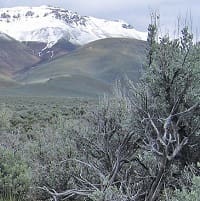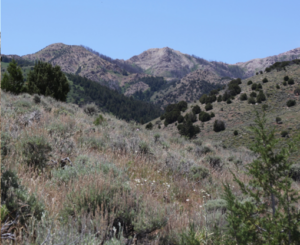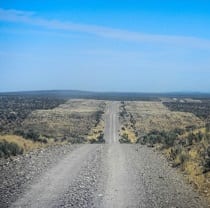Invasive Species
The US Geological Survey Land Management Research Program and the Great Basin Fire Science Exchange teamed up to bring you updates in sagebrush, fire, and wildlife related research.
Dates, Topics, and Presentations:
1/30 – Sage-grouse, carbon topics
Webinar recording
Summary webpage
Program with speakers, talks, and resources
- Greater sage-grouse hierarchical population monitoring framework: Range-wide application of an early warning systems for populations at-risk – Coates, Weise et al.
- Evaluating the effectiveness of conservation actions directed for greater sage-grouse using hierarchical models and the Conservation Efforts Database – Coates et al.
- Greater sage-grouse range-wide seasonal habitat maps: Identifying regional thresholds and relationships between trends and seasonal habitat use – Wann et al.
- Characterizing the environmental drivers of range-wide gene flow for greater sage-grouse – Zimmerman et al.
- Characterizing greater sage-grouse climate driven maladaptation – Zimmerman et al.
- Quantifying carbon storage and greenhouse gas emissions in sagebrush rangelands to inform management for carbon resilience – Bagcilar et al.
2/6 – Invasive species, restoration effectiveness, and monitoring
Webinar recording
Summary webpage
Program with speakers, talks, and resources
- Develop annual herbaceous percent cover maps in near-real time – Boyte et al.
- Proliferation of fine fuels: Assessing under future climatic conditions – Roche et al.
- Optimizing sagebrush restoration and management actions to increase connectivity within the Sagebrush Conservation Design – Tarbox et al.
- Assessing cheatgrass treatment efficacy across the sagebrush biome – Tarbox et al.
- Simulating trends in land health components under treatment scenarios and Sagebrush Conservation Design – Christensen et al.
- Biome-wide vegetation change monitoring and warning system – Aldridge et al.
- Vectors of annual grass invasion – Roche et al.
- Predicting reburn risk to restoration investments – Applestein et al.
2/20 – Monitoring, pinyon-juniper, and fuels management
Webinar recording
Summary webpage
Program with speakers, talks, and resources
- Planning for conservation delivery success: Linking biome-wide Sagebrush Conservation Design to local treatment planning by leveraging landscape restoration outcomes- Arkle et al.
- Technical transfer tools for the Nevada and Oregon rangeland monitoring project (NORMP) – Pilliod et al.
- Rapid and Other Assessment and Monitoring Methods (ROAM) project – Jeffries et al.
- Pinyon-juniper treatments for minimizing climate and fire vulnerability – Noel et al.
- Synthesis and forecasts of pinyon-juniper woodland die-off – Wion (No recording)
- Synthesizing scientific information on treatment and natural disturbance effects on pinyon-juniper woodlands and associated wildlife habitat – Halperin et al.
2/27 – Fire, fuels management, invasive species –
Webinar recording
Summary webpage
Program with speakers, talks, and resources
- Effectiveness of layering treatments in the “multiple-intervention” response to wildfire in sagebrush steppe – Germino et al.
- A collaborative and iterative framework for delivering applied fuel break science: With a focus on sagebrush ecosystems and the Great Basin – Shinneman et al.
- UAS survey of sagebrush fuel breaks – Shinneman et al.
- Invasive annual grass – Economic assessment – Orning et al.
- Longevity of herbicides targeting exotic annual grasses in sagebrush-steppe soils – Germino et al.
- Synthesis of indaziflam outcomes for protecting sagebrush ecosystems – Roche et al.
- Can ruderal components of biocrust be maintained under increasing threats of drought, grazing, and wild horses? Condon et al.
3/6 – Climate, vegetation trends, and big game
Webinar recording
Summary webpage
Program with speakers, talks, and resources
- Rangeland Condition Monitoring Assessment and Projection (RCMAP) vegetation trend summaries – Rigge
- Integrating climate, sagebrush ecological integrity, and grazing – Holdrege et al.
- Influence of future climate scenarios on habitat and population dynamics of greater sage-grouse – O’Neil et al.
- Understanding and forecasting environmental controls over plant establishment in sagebrush ecosystems to enhance restoration success – Siegmund, Stears et al.
- Treatment and post-fire assessment tools for management of the sagebrush ecosystem – Duniway, Tyree et al.
- Science to support elk management efforts to reduce CWD risk – Janousek et al.
View article.
We created range-wide phenology forecasts for two problematic invasive annual grasses: cheatgrass, and red brome . We tested a suite of 18 mechanistic phenology models using observations from monitoring experiments, volunteer science, herbarium records, timelapse camera imagery, and downscaled gridded climate data to identify the models that best predicted the dates of flowering and senescence of the two invasive grass species. We found that the timing of flowering and senescence of cheatgrass and red brome were best predicted by photothermal time models that had been adjusted for topography using gridded continuous heat-insolation load index values. Phenology forecasts based on these models can help managers make decisions about when to schedule management actions such as grazing to reduce undesirable invasive grasses and promote forage production, quality, and biodiversity in grasslands; to predict the timing of greatest fire risk after annual grasses dry out; and to select remote sensing imagery to accurately map invasive grasses across topographic and latitudinal gradients. These phenology models also have the potential to be operationalized for within-season or within-year decision support.
View article.
Distributions of both native and invasive species are expected to shift under future climate. Species distribution models (SDMs) are often used to explore future habitats, but sources of uncertainty including novel climate conditions may reduce the reliability of future projections. We explore the potential spread of the invasive annual grass ventenata (Ventenata dubia) in the western United States under both current and future climate scenarios using boosted regression tree models and 30 global climate models (GCMs). We quantify novel climate conditions, prediction variability arising from both the SDMs and GCMs, and the agreement among GCMs. Results demonstrate that currently suitable habitat is concentrated inside the invaded range of the northwest, but substantial habitat exists outside the invaded range in the Southern Rockies and southwestern US mountains. Future suitability projections vary greatly among GCMs, but GCMs commonly projected decreased suitability in the invaded range and increased suitability along higher elevations of interior mountainous areas.
View article.
Ecological disturbance can affect carbon storage and stability and is a key consideration for managing lands to preserve or increase ecosystem carbon to ameliorate the global greenhouse gas problem. Dryland soils are massive carbon reservoirs that are increasingly impacted by species invasions and altered fire regimes, including the exotic-grass-fire cycle in the extensive sagebrush steppe of North America. Direct measurement of total carbon in 1174 samples from landscapes of this region that differed in invasion and wildfire history revealed that their impacts depleted soil carbon by 42-49%, primarily in deep horizons, which could amount to 17.1-20.0 Tg carbon lost across the ~400,000 ha affected annually. Disturbance effects on soil carbon stocks were not synergistic, suggesting that soil carbon was lowered to a floor-i.e. a resistant base-level-beneath which further loss was unlikely. Restoration and maintenance of resilient dryland shrublands/rangelands could stabilize soil carbon at magnitudes relevant to the global carbon cycle.
View article.
We seeded perennial grass (Elymus elymoides) at multiple depths to determine susceptibility and resistance. Herbicides were applied at full and reduced rates to mimic the effect of litter in natural systems. We observed reductions in most non-native species in all treatments, but also extensive reductions of native annual forbs, although these were offset at lower application rates, and some species (e.g. Amsinckia tessellata and Microsteris gracilis) were less susceptible than others. Herbicides, particularly indaziflam, reduced E. elymoides emergence, but planting seeds at 2–3 cm depths improved emergence, particularly for imazapic, with 15–68% greater emergence than seeds planted at 1 cm. We suggest surveys for native annual forbs and resistant invaders before applying herbicides and field testing to determine whether reduced rates could provide weed control while maintaining annual forbs. We suggest planting E. elymoides at 2–3 cm when applying herbicides, an approach that may be effective for other species. Herbicide use can be an effective tool, but our results indicate that mitigation of nontarget effects will be needed to maintain native plant diversity.
Read article.
Overall, indaziflam + imazapic had greater initial control of cheatgrass, but by 2023, both treatments led to similar ∼17 percentage-point reductions in cheatgrass cover. Cheatgrass individuals that “escaped” the herbicide treatment grew exceptionally large and fecund. There were no reductions in cover in any native vegetation type, including biocrusts, and nontarget increases in cover were observed for 1) deep-rooted perennial grasses treated with indaziflam + imazapic in the 2011 burn subregion and 2) the shallow-rooted Sandberg bluegrass (Poa secunda) treated with either herbicide in the 2011 or 2011 + 2019 burn subregions. Consideration of burn legacies, pretreatment landscape condition, and evenness of treatment application may improve restoration outcomes and help prioritize management allocation, timing, and treatment expectations.
View article.
Our research shows that across deserts, grasslands, and forests, plant communities with higher abundance of naturalized species are more acquisitive above and belowground, shorter, more shallowly rooted, and less dependent on mycorrhizal symbionts for resource acquisition. These functional shifts likely drive observed changes in carbon storage, litter decomposition, and nutrient and water cycling in invaded ecosystems. This mechanistic understanding of functional community change is a crucial step toward predicting and mitigating impacts of naturalized and invasive species.
View article.
Using the Gunnison sage-grouse as a case study, we leveraged existing resource selection function models to identify areas of high restoration potential across landscapes with variable habitat conditions and habitat-use responses. We also tested how this information could be used to improve restoration planning. We simulated change in model covariates across crucial habitats for a suite of restoration actions to generate heatmaps of relative habitat suitability improvement potential, then assessed the degree to which use of these heatmaps to guide placement of restoration actions could improve suitability outcomes. We also simulated new or worsening plant invasions and projected the resulting loss or degradation of habitats across space. We found substantial spatial variation in projected changes to habitat suitability and new habitat created, both across and among crucial habitats. Use of our heatmaps to target placement of restoration actions improved habitat suitability nearly fourfold and increased new habitat created more than 15-fold, compared to placements unguided by heatmaps. Our decision-support products identified areas of high restoration potential across landscapes with variable habitat conditions and habitat-use responses. We demonstrate their utility for strategic targeting of habitat restoration actions, facilitating optimal allocation of limited management resources to benefit species of conservation concern.
This special issue of Rangeland Ecology and Management is dedicated to applying the Sagebrush Conservation Design (SCD) to improve conservation outcomes across the sagebrush biome in the face of pervasive ecosystem threats.
Articles included:
State of the sagebrush: Implementing the Sagebrush Conservation Design to save a biome
Closing the conservation gap: Spatial targeting and coordination are needed for to keep pace with sagebrush losses
Climate change amplifies declines in sagebrush ecological integrity
Well-connected core areas retain ecological integrity of sagebrush ecosystems amidst overall declines 2001–2021
Spatial prioritization of conifer management to defend and grow sagebrush cores
A strategic and science-based framework for management of invasive annual grasses in the sagebrush biome
Modeling cropland conversion risk to scale-up averted loss of core sagebrush rangelands
Characterizing wildfire risk for the Sagebrush Conservation Design
An assessment of conservation opportunities within sagebrush ecosystems of US National Parks and Wildlife Refuges
Tool to promote stepping down the Sagebrush Conservation Design to local conservation planning
Exploring the sage grouse initiative’s role in defending and growing sagebrush core areas
Satellite remote sensing to assess shrubland vegetation responses to large-scale juniper removal in the northern Great Basin
Cooperative conservation actions improve sage-grouse population performance within the bi-state distinct population segment
Evaluating the Sagebrush Conservation Design Strategy through the performance of a sagebrush indicator species
How a Sagebrush Conservation Strategy benefits rangeland birds
Carbon Security Index: Novel approach to assessing how secure carbon is in sagebrush ecosystems within the Great Basin
Using technical transfer to bridge science production and management action
Assessing conservation readiness: The where, who, and how of strategic conservation in the sagebrush biome
Where do we go from here with sagebrush conservation: A long-term perspective?
There is no hope without change: A perspective on how we conserve the sagebrush biome
View article.
Abundances of dominant invaders, cheatgrass and Russian thistle, were measured along treated and neighboring untreated edges in 40 paired plots along ∼61 km of 60-m wide fuel breaks. Fuel breaks were constructed using a variety of shrub-cutting and herbicide applications 1–4 yr before measurement. Generalized linear mixed effect models revealed that fractional cover significantly increased in treated compared with untreated areas by 0.02–0.12 for cheatgrass and 0–0.06 for Russian thistle within 9 m of treatment boundaries (on a scale of 0-1). We neither detected increased invasion in adjacent and untreated areas nor gradients of increasing invasion with proximity to treatment boundaries. Although these findings reveal invasions that were otherwise undetected across the entire 60 m width of fuel breaks, invasion levels did not surpass nominal management thresholds for fire behavior or risk of conversion to annual grasslands.





